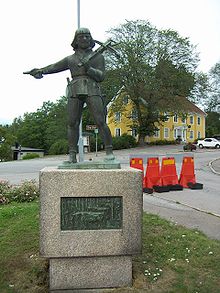Nils Dacke

Nils Dacke († 1543 ) was a Swedish peasant and resistance leader from the southern Swedish province of Småland .
He was the leader of the so-called Dacke uprising against King Gustav Wasa , which was suppressed by royal troops and German mercenaries. As the leader of the uprising, the vanquished did not have the economic resources that Gustav Wasa had. In addition, he renounced the help of German nobles (e.g. Duke Albrecht von Mecklenburg - it is also highly uncertain whether he was even able to hire the necessary troops).
Nils Dacke first appears by name in Swedish history in 1536 when he kills a governor during some minor riots in Småland. At that time, Dacke, who also had at least one son, is said to have been around 30 years old. He was then on the run for a long time. The escape ended up in court, however, from which he was sentenced to a fine of 200 marks, which was a very large sum at the time. With the help of residents of his home region Södra Möre in southeast Småland and the support of relatives, he was able to raise the sum and then settle in a newly built house on the border with Blekinge .
A few years later, the name Dackes appears again in history. This time he was the leader of a group of peasants in his district who no longer wanted to be suppressed by the rulers. A few months later, Dacke found himself in a position of power that he had not expected as a peasant leader in Småland. He signed a peace agreement with Gustav Wasa on November 8, 1542, instead of moving to Stockholm with his troops . It seems as if he wants to fulfill the motto “ Gammelt och fornt ”. As lord of the Kronoborg fortress , he revived the border trade with Denmark and, among other things, made Catholic services possible. In the spring of 1543 Dacke was attacked by royal troops contrary to the agreements. These won an overwhelming victory as they were now familiar with the fighting techniques of the peasants. Traditionally, Dacke was badly wounded. In the decisive battle on the ice of Lake Hjorten in the parish of Virserum , he is said to have been hit on both legs. Before he could be caught, his people managed to get him to safety and hide him for two months, but after that they were tracked down.
Dacke fell in the final fighting on the border with Blekinge (Ledja / Holmsjö) near the farm where he had worked for the Vogt at the beginning of the uprising. His body was cut into several parts and displayed in squid on a gallows with the head impaled on a post. Some unconfirmed sources show that Gustav Wasa let Dacke's son starve to death in a prison because he feared new unrest and the symbolic value of the son.
literature
- Gerhard Hafström, "Nils Dacke före Dackefejden", Personhistorisk tidskrift , 1928
- Lars-Olof Larsson, Det medeltida Värend , 1964, 4 uppl. 1975
- Lars-Olof Larsson, Dackeland , 1979
- Albert Vejde, "Nils Dacke och hans fejd", Hyltén-Cavallius-Föreningens årsskrift 1943.
- Alf Åberg, Nils Dacke och landsfadern , 1960
- Alf Henrikson , "Dackefejden", Svensk historia, del II , 1963
Others
Various car ferries used by the TT-Line were named after Nils Dacke. In 1998 an asteroid was named after him: (7217) Dacke .
| personal data | |
|---|---|
| SURNAME | Dacke, Nils |
| BRIEF DESCRIPTION | Swedish peasant and resistance leader |
| DATE OF BIRTH | 15th century or 16th century |
| DATE OF DEATH | 1543 |
